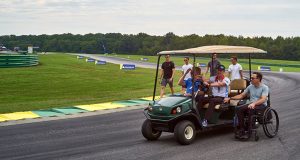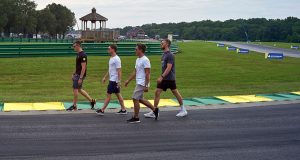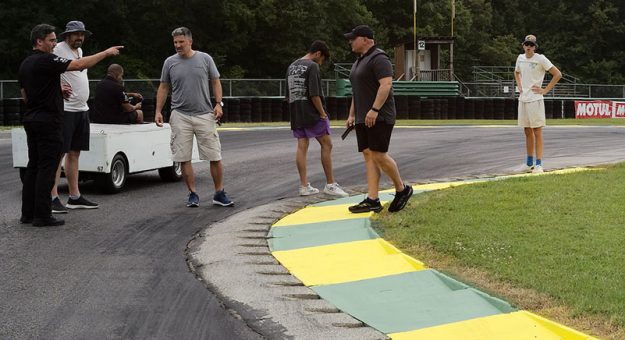Track Walks Are an Important Preparation Piece for a Race Weekend
By John Oreovicz
DAYTONA BEACH, Fla. – IMSA issues an official schedule for every WeatherTech SportsCar Championship event. Each race weekend includes at least one dedicated time slot for a track walk, a quiet period when drivers, engineers and other team personnel have the opportunity to walk the racecourse to look for areas where they might gain an advantage later in the weekend from the pit stand or behind the wheel.
Yes, “track walk” is pretty self-explanatory and simple in concept. It’s the chance to study a racetrack at a slow pace in great detail. Simulators can help drivers learn a track’s basic layout and fundamental characteristics, and even assist an engineer in devising a basic chassis setup, but by putting in a bit of old-fashioned legwork and observation, they can pick up so much more.
“It’s quite important during the track walk to notice all the technicalities of the track,” said Jules Gounon, co-driver of the No. 79 WeatherTech Racing Mercedes-AMG GT3 in the GT Daytona (GTD) class with Cooper MacNeil.
“I go through all the details. You can see during a track walk if you have cracks in the tarmac, if you have camber in the corners, if there is sand inside the curbs. Where can we afford to go off, and where can we not?
“Sometimes it’s good to walk with the engineers because you can talk about different topics for the weekend. What are we going to do strategy-wise? What are we looking for from the setup? Sometimes you see things you would not have thought about if you weren’t out there talking about it.”

As Gounon pointed out, every corner at a racetrack is a complex equation that involves far more thought than left/right or fast/slow. What is the grip level of the surface? Are there transitions from asphalt to concrete? Are there bumps that could unsettle the balance of the car? Have the curbs or walls been modified – which is of particular importance on street circuits like Long Beach that feature minute variances each year?
A typical track walk takes about an hour, dependent on the length and the physical difficulty of walking the course. Some longer circuits permit use of a pit cart. For the upcoming season finale at Michelin Raceway Road Atlanta, with five IMSA-sanctioned series and hundreds of drivers racing, two track walk sessions – walking only, no carts – are on the schedule for Wednesday, Sept. 28.
Michael Lewis, defending champion of the Touring Car (TCR) class of the IMSA Michelin Pilot Challenge along with Taylor Hagler, focuses on the mental aspect of driving during the track walk so his reactions flow naturally when he is at speed in the No. 1 Bryan Herta Autosport with Curb-Agajanian Hyundai Elantra N TCR.
“I feel like you have to do a track walk at every track – it’s more than just a habit,” Lewis stated. “You can probably just show up blind and go fast, but the track walk always shows you something new.
“I’m trying to pick out reference points, mainly for outright qualifying pace,” he added. “But you also have to work on flow, too. So, it’s kind of a balance. You start out focusing on very concrete things like braking points, apexes, acceleration points. But then you start to incorporate that flow, and the feel that you are looking for out of the car.”

Unlike Lewis, Gounon doesn’t believe a track walk is an absolute requirement. But it’s something he looks forward to for a variety of reasons.
“I am lucky enough to be racing professionally in GT3 for seven years now, so I know most of the tracks,” he says. “If it’s a new track, then it’s definitely important to go. And there are often changes to existing tracks, so when there is new pavement or new curbing, you want to see up close what kind of damage it could do to the car, especially in the first laps when the cars are heavy with fuel.
“But normally, I don’t take the track walk too seriously, because then you lose the fun,” he added. “For me, it’s important to have fun while you are racing. That’s when I perform the best. So, I go with my feeling. I do a track walk when I want to do one. Like, if I am coming back from Europe, if I am feeling a bit of jet lag, it’s also a good way to do a bit of exercise.”
